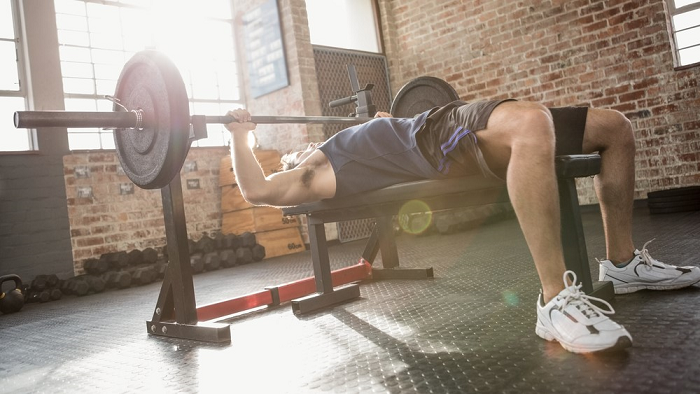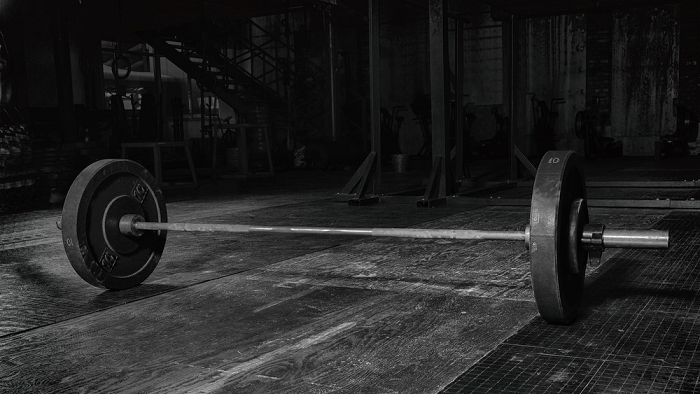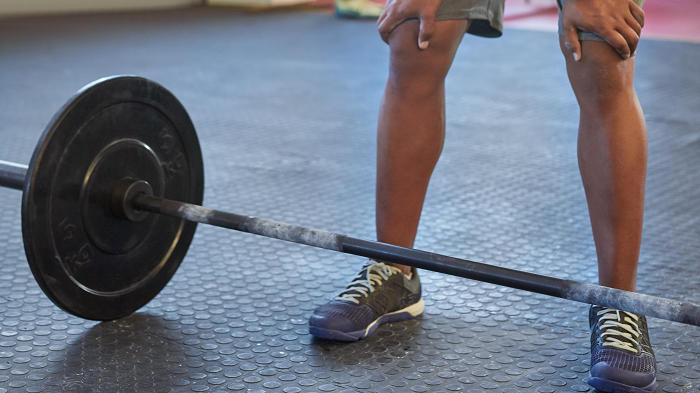Phase 1 — Building the Gentleman Spy Body
Lesson 3 — Barbell Workout
ATTENTION: Before starting the Gentleman Spy Workout, you must have a clean bill of health. This workout is designed to minimize your rate of injury — both in weight training and in the rest of your life. You must practice the exercises and understand how to properly perform them. By performing the workouts recommended here, you agree that you take full responsibility for your life, choices, and actions. Anything that happens because of this program — good or bad — is your fault and your fault only.
LESSON 3: Barbell Workout

In the words of legendary strength coach Mark Rippetoe, “Strong people are harder to kill, and generally more useful.” This describes the Gentleman Spy perfectly; this is who you need to be.
Building strength and size is neither complex, nor does it require high-tech equipment, but it is hard. Strength and size are not obtained without hard work; that work will harden your body and your mind.
Barbell Workout

You will be focusing on the basic exercises of the strongest in the world: powerlifters and Olympic weightlifters. You will perform the squat, bench press, deadlift, press, power clean, pullups, and chinups.
Whether you have access to a full gym or only your bodyweight at home, all these exercises are scalable and translate well between bodyweight, barbell, and kettlebell versions.
NOTE: If you have questions on how to properly perform any of the exercises, consult an experienced coach and make sure you read the info and watch the videos linked below to understand the nuances of the various exercises.
StrongLifts exercise descriptions
Rip coaching the squat, bench press, press, deadlift, and power clean (3 positions, putting it together)
Art of Manliness playlist with Mark Rippetoe
This workout is designed to be performed three times per week, though it is scalable to two days if necessary. Because a Monday/Wednesday/Friday routine works well for most people, that’s what we will use in the example schedule, but feel free to move days around as your schedule necessitates. Just be sure to take at least a day between strength workouts.
Workout A:
- Squat
- Bench Press
- Pullups/Chin-ups (alternating)
Workout B:
- Squat
- Overhead Press
- Deadlift/Power Clean (alternating)
Sets, Reps, and Weights

Assuming you have never — or not recently — completed a powerlifting based workout such as this one, the prescription looks deceptively easy: five sets of five reps (5×5) for all exercises except the deadlift which will be one set of five reps (1×5).
You will start with the bar (45lb Olympic bar) and work up from there, adding five pounds (2.5 lbs. per side) per workout for all exercises except the power clean, where you will add ten pounds (5 lbs. per side), and deadlift, where you will start with 95lbs (the bar, plus one 25lb plate on each side) and add twenty pounds (10 lbs. per side). Pullups and Chinups are done to failure until you can complete 15 reps, at which point you’ll start adding 5 pounds per workout using a weighted belt or vest.
The exercises are done sequentially, rather than in circuit. You will complete all five sets of your squats before moving on to the presses, where you will complete all five sets before moving on to the pulls.
An Example schedule looks like the following (Weight x Sets x Reps):
| Monday | Wednesday | Friday | |
| Week 1 | Workout A Squat 45 x 5 x 5 Bench Press 45 x 5 x 5 Pullups (unweighted, 5 sets to failure) | Workout B Squat 50 x 5 x 5 Press 45 x 5 x 5 Deadlift 95 x 1 x 5 | Workout A Squat 55 x 5 x 5 Bench Press 50 x 5 x 5 Chinups (unweighted, 5 sets to failure) |
| Week 2 | Workout B Squat 60 x 5 x 5 Press 50 x 5 x 5 Power Clean 45 x 5 x 5 | Workout A Squat 65 x 5 x 5 Bench Press 55 x 5 x 5 Pullups (unweighted, 5 sets to failure) | Workout B Squat 70 x 5 x 5 Press 55 x 5 x 5 Deadlift 115 x 1 x 5 |
| Week 3 | Workout A Squat 75 x 5 x 5 Bench Press 60 x 5 x 5 Chinups (unweighted, 5 sets to failure) | Workout B Squat 80 x 5 x 5 Press 60 x 5 x 5 Power Clean 55 x 5 x 5 | Workout A Squat 85 x 5 x 5 Bench Press 65 x 5 x 5 Pullups (unweighted, 5 sets to failure) |
| Week 4 | Workout B Squat 90 x 5 x 5 Press 65 x 5 x 5 Deadlift 135 x 1 x 5 | Workout A Squat 95 x 5 x 5 Bench Press 70 x 5 x 5 Chinups (unweighted, 5 sets to failure) | Workout B Squat 100 x 5 x 5 Press 70 x 5 x 5 Power Clean 65 x 5 x 5 |
| Week 5 | Workout A Squat 105 x 5 x 5 Bench Press 75 x 5 x 5 Pullups (unweighted, 5 sets to failure) | Workout B Squat 110 x 5 x 5 Press 75 x 5 x 5 Deadlift 155 x 1 x 5 | Workout A Squat 115 x 5 x 5 Bench Press 80 x 5 x 5 Chinups (unweighted, 5 sets to failure) |
| Week 6 | Workout B Squat 120 x 5 x 5 Press 80 x 5 x 5 Power Clean 75 x 5 x 5 | Workout A Squat 125 x 5 x 5 Bench Press 85 x 5 x 5 Pullups (unweighted, 5 sets to failure) | Workout B Squat 130 x 5 x 5 Press 85 x 5 x 5 Deadlift 175 x 1 x 5 |
| Week 7 | Workout A Squat 135 x 5 x 5 Bench Press 90 x 5 x 5 Chinups (unweighted, 5 sets to failure) | Workout B Squat 140 x 5 x 5 Press 90 x 5 x 5 Power Clean 85 x 5 x 5 | Workout A Squat 145 x 5 x 5 Bench Press 95 x 5 x 5 Pullups (unweighted, 5 sets to failure) |
| Week 8 | Workout B Squat 150 x 5 x 5 Press 95 x 5 x 5 Deadlift 195 x 1 x 5 | Workout A Squat 155 x 5 x 5 Bench Press 100 x 5 x 5 Chinups (unweighted, 5 sets to failure) | Workout B Squat 160 x 5 x 5 Press 100 x 5 x 5 Power Clean 95 x 5 x 5 |
| Week 9 | Workout A Squat 165 x 5 x 5 Bench Press 105 x 5 x 5 Pullups (unweighted, 5 sets to failure) | Workout B Squat 170 x 5 x 5 Press 105 x 5 x 5 Deadlift 215 x 1 x 5 | Workout A Squat 175 x 5 x 5 Bench Press 110 x 5 x 5 Chinups (unweighted, 5 sets to failure) |
| Week 10 | Workout B Squat 180 x 5 x 5 Press 110 x 5 x 5 Power Clean 105 x 5 x 5 | Workout A Squat 185 x 5 x 5 Bench Press 115 x 5 x 5 Pullups (unweighted, 5 sets to failure) | Workout B Squat 190 x 5 x 5 Press 115 x 5 x 5 Deadlift 235 x 1 x 5 |
| Week 11 | Workout A Squat 195 x 5 x 5 Bench Press 120 x 5 x 5 Chinups (unweighted, 5 sets to failure) | Workout B Squat 200 x 5 x 5 Press 120 x 5 x 5 Power Clean 115 x 5 x 5 | Workout A Squat 205 x 5 x 5 Bench Press 125 x 5 x 5 Pullups (unweighted, 5 sets to failure) |
| Week 12 | Workout B Squat 210 x 5 x 5 Press 255 x 5 x 5 Deadlift 175 x 1 x 5 | Workout A Squat 215 x 5 x 5 Bench Press 130 x 5 x 5 Chinups (unweighted, 5 sets to failure) | Workout B Squat 220 x 5 x 5 Press 130 x 5 x 5 Power Clean 125 x 5 x 5 |
| Week 13 | Workout A Squat 225 x 5 x 5 Bench Press 135 x 5 x 5 Pullups (unweighted, 5 sets to failure) | Workout B Squat 230 x 5 x 5 Press 135 x 5 x 5 Deadlift 275 x 1 x 5 | Workout A Squat 235 x 5 x 5 Bench Press 140 x 5 x 5 Chinups (unweighted, 5 sets to failure) |
| Week 14 | Workout B Squat 240 x 5 x 5 Press 140 x 5 x 5 Power Clean 135 x 5 x 5 | Workout A Squat 245 x 5 x 5 Bench Press 145 x 5 x 5 Pullups (unweighted, 5 sets to failure) | Workout B Squat 250 x 5 x 5 Press 145 x 5 x 5 Deadlift 295 x 1 x 5 |
| Week 15 | Workout A Squat 255 x 5 x 5 Bench Press 150 x 5 x 5 Chinups (unweighted, 5 sets to failure) | Workout B Squat 260 x 5 x 5 Press 150 x 5 x 5 Power Clean 145 x 5 x 5 | Workout A Squat 265 x 5 x 5 Bench Press 155 x 5 x 5 Pullups (unweighted, 5 sets to failure) |
| Week 16 | Workout B Squat 270 x 5 x 5 Press 155 x 5 x 5 Deadlift 315 x 1 x 5 | Workout A Squat 275 x 5 x 5 Bench Press 160 x 5 x 5 Chinups (unweighted, 5 sets to failure) | Workout B Squat 280 x 5 x 5 Press 160 x 5 x 5 Power Clean 155 x 5 x 5 |
By three months into this program, you’ll likely be lifting more weight than you ever have before. The workouts that you thought might have been too light before will now be brutal. You’re probably squatting your bodyweight, and some of you will be pushing almost 1.5 times your bodyweight. You will be stronger, harder, and leaner. Friends, family, and coworkers will notice the massive change in your physique. Your confidence will be through the roof. All from a program that appears easy on paper.
Warming Up

Following the workout as prescribed, starting with an empty bar on most exercises, you won't need much of a warm up for your first few weeks.
As you progress, warming up will become a necessary component of your workout. Going straight into a heavy work set is begging for injury.
Using a general full body warm up before hitting the weights is personal preference. If you decide to complete a general warmup, easy bodyweight movements to loosen up works well; something like two rounds of five pullups, ten pushups, and fifteen squats. This isn't necessarily required, so play around and see what works and feels best for you.
Warm up each exercise progressively. Start with one or two sets of five reps on an empty bar, then five reps with about 40% of your work weight, three reps with 60%, two reps with 80-85%, then get into the 5x5 with your prescribed weight.
So, the warmup for a 150lb bench press would look like:
45 x 2 x 5
60 x 1 x 5
90 x 1 x 3
120 x 1 x 2
150 x 5 x 5
Sticking to strict percentages often makes it a pain to load/unload the bar between warmup sets, so you can err on the side of ease/speed:
45 x 2 x 5
65 x 1 x 5
95 x 1 x 3
115 x 1 x 2 (or 125, or even 135lbs if you're feeling sporty)
150 x 5 x 5
To use a 225lb squat as an example, the "textbook" warmup would be:
45 x 2 x 5
90 x 1 x 5
135 x 1 x 3
180 x 1 x 2
225 x 5 x 5
Adjusted for speed and ease of use, it would look like:
45 x 2 x 5
95 x 1 x 5
135 x 1 x 3
185 x 1 x 2
225 x 5 x 5
The only place you should really change your warmup is on the deadlift: you need plates on the bar to get a proper starting position and you're already warmed up from the squats. For your first few workouts, you can do a warmup set at 95lbs, but once you're lifting more than a couple hundred pounds, start the warmup at 135lbs.
Stalling/Deloading/Resetting

Between the two- to three-month mark, you might have to start worrying about stalling, deloading, and resetting. We’ll cover each in order:
Stalling is when you’re no longer able to add five pounds per workout. Your squat might look like Monday: 195 x 5 x 5, Wednesday: 205 x 5, 5, 4, 3, 2 (5 reps on the first and second set, then four reps on the third set, three on the third, and two reps on the last set).
At this point, repeat the weight – remember, you don’t move up in weight until you get the full 5 x 5. If on Friday you get 205 x 5, 5, 5, 4, 3, you can repeat one final time. If you still don’t make 5×5 on the third attempt, it’s time to deload.
Deloading is exactly what it sounds like. You’ve maxed out your body’s ability to recover in the days between workouts, so now you need to give it a bit of a break. But not much.
All you’re doing at this point is taking 10% off the weight and going back up as normal. So, if you stalled at 205, drop down to 185. You’re still going for 5×5, and you’ll just climb back up. If you stalled on Friday, the next week would be Monday: 185 x 5 x 5, Wednesday: 190 x 5 x 5, Friday: 195 x 5 x 5. When you get back up to 205, you should be able to blow right through it and continue going.
Resetting is basically a hard deload. In contrast to normal stalling, which looks like the above example, you might get something that looks like this: Mon: 205 x 5, 5, 4, 3, 2; Wed: 5, 5, 5, 4, 3; Fri: 5, 5, 4, 2, 1.
At this point, it’s time to take a more serious break. For the stalled exercise only, drop the weight 20%, and only do 3×3 for one week. Then you’d start adding weight and working back up again. A reset after a 205lb squat would look like:
- Mon: 205 x 5, 5, 4, 3, 2
- Wed: 205 x 5, 5, 5, 4, 3
- Fri: 205 x 5, 5, 3, 2, 1
- Mon: 165 x 3 x 3
- Wed: 165 x 3 x 3
- Fri: 165 x 3 x 3
- Mon: 170 x 5 x 5
- Wed: 175 x 5 x 5
- Fri: 180 x 5 x 5
- And so on…
By the time you stall on squats, you will likely have stalled at least twice on overhead presses. Don’t worry, just keep running the program as it’s designed. Keep adding weight to the exercises you can and run through the stalls and deloads on individual exercises as necessary.
Next Steps

Do not change the overall program until you’re squatting about 1.5 times your bodyweight, and/or you’ve stalled on your squats at least twice.
At this point, you have some options. The simplest recommendation is to simply transition from 5×5 to 3x5 (three sets of five reps), then from 3x5 to 3×3 (three sets of three reps) while keeping everything else the same. You’ll still be adding weight every workout, and the reduced volume will allow you to continue getting stronger for longer.
Eventually, you will stall on 3×3 as well. You are transitioning from a novice to an intermediate lifter. You will be incredibly strong and dense and have more functional strength than almost all of your peers.
At this point, you can start looking into other programs — either a more periodized weightlifting program, or sport-specific programs if there’s something you want to concentrate on.
Assuming you want to continue barbell training, look at the following programs:
Practical Programming Advanced Novice
Texas Method (full details in Practical Programming)
Madcow (via Starting Strength wiki or StrongLifts)
Only after you’ve spent the time getting incredibly strong on these total body workouts is it worth looking into a lower-volume program like Doug McGuff’s Body by Science or similar HIT programs, or more variable programs like CrossFit.
PROGRAM
DOWNLOADS
 Barbell Workout Cheat Sheet
Barbell Workout Cheat SheetMaster the barbell moves of the strongest in the world. Squat, press, and deadlift more than ever before.
In the next lesson...
Continue building the Gentleman Spy Body with the speed and skill workouts that will make you faster and leaner than ever before.
